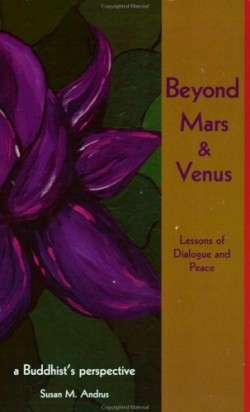Beyond Mars & Venus
Lessons of Dialogue and Peace a Buddhist's perspective
What began as a lighthearted lunchtime counterpoint, for a friend who was using John Gray’s Mars/Venus ideas to guide a relationship, became a gentle corrective to those generalizations that espouse how men are, what women want, and dispense relationship advice based on gender stereotypes.
With the goal of helping others find joy in relationships using Buddhist principles, the author (a practicing Buddhist, psychologist, wife, mother, ex-wife, and friend) discovered that dialogue, informed by her Buddhist practices, provides a grounded, practical way to nurture and transform relationships through communication. Dialogue isn’t about controlling or changing the other person, she says. Rather, it is a tool for understanding and appreciating differences, creating “a place where both men and women thrive with feelings of harmony, mutual respect, and trust in spite of their difference.”
At the heart of the process is the chapter called “Anatomy of a Dialogue.” Its nine points allow challenging and emotion-laden communications to proceed toward peaceful results, tackling topics like pleasant or unpleasant touch, sexuality, guilt, even world peace. Anecdotes and a list of her family’s dialogue ground rules used over Sunday dinner illustrate how these communication concepts can be used with children.
Ending relationships is a painful hurdle for most people. The author describes how she continues in relationship with her ex-husband and children after the breakup of her thirty-plus year marriage: “Chanting, apologizing, appreciating, and praying enabled us to keep our relationships with each other intact even though my husband and I were no longer married.” These were practices, she noted, that allowed her to overcome the human tendencies “toward greed, anger, and foolishness.” Quotes from the Buddhist tradition are interspersed with such passages, expanding and adding a resonant depth to the ideas.
Practicing peace with the least peaceful people is a powerful consideration in these times and a valuable section in the book. Expanding on these ideas with more detail would have further enriched the book and increased its usefulness as a peace-promoting manual.
Covering issues like manipulation, control, cause and effect, and how to use conflict to grow healthy relationships, this book serves as a guide for bringing out the best in oneself, while using dialogue to recognize and draw out the best within others. This refreshing addition to the relationship shelf takes a responsible, win-win approach to communicating that builds from ancient Buddhist practices.
Reviewed by
Bobbye Middendorf
Disclosure: This article is not an endorsement, but a review. The publisher of this book provided free copies of the book to have their book reviewed by a professional reviewer. No fee was paid by the publisher for this review. Foreword Reviews only recommends books that we love. Foreword Magazine, Inc. is disclosing this in accordance with the Federal Trade Commission’s 16 CFR, Part 255.

